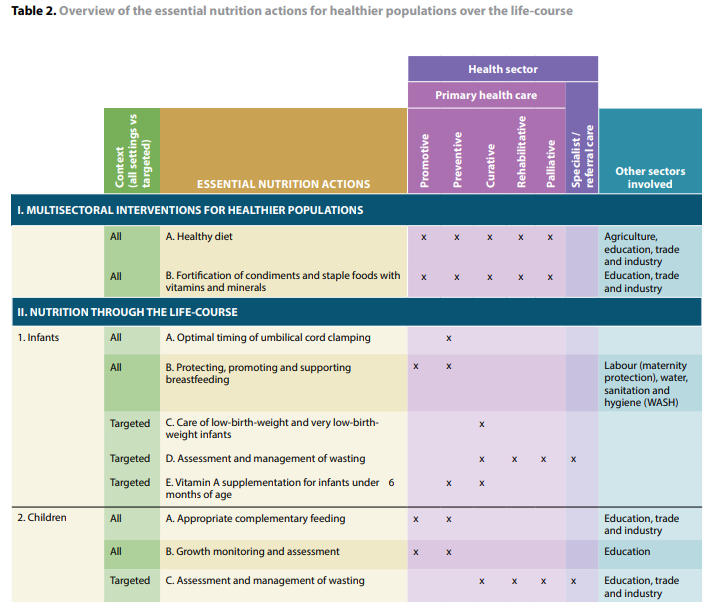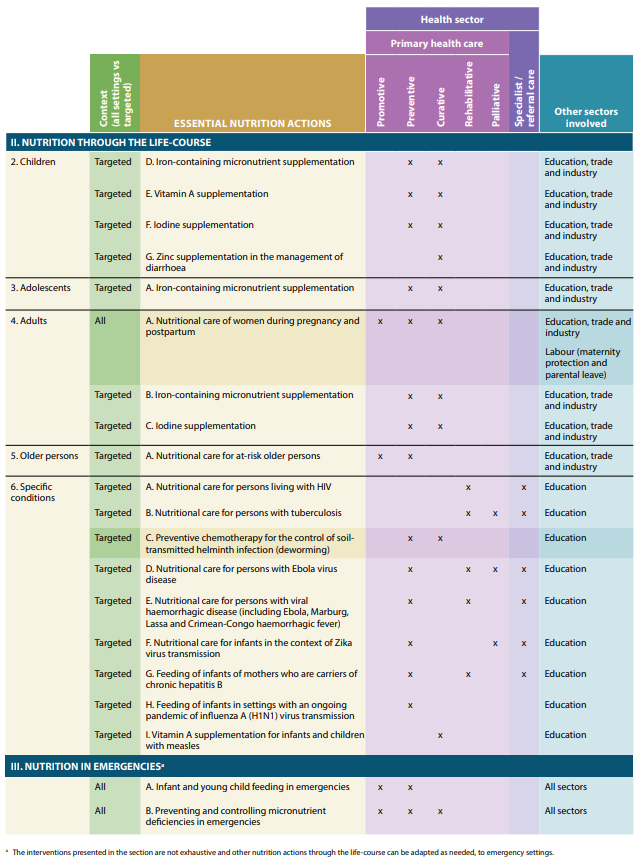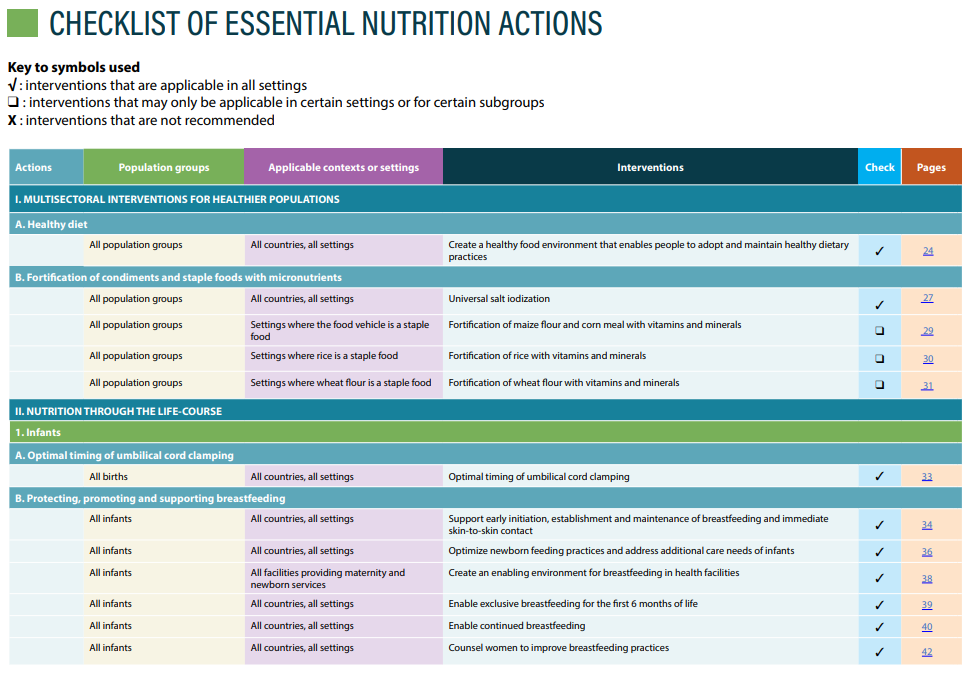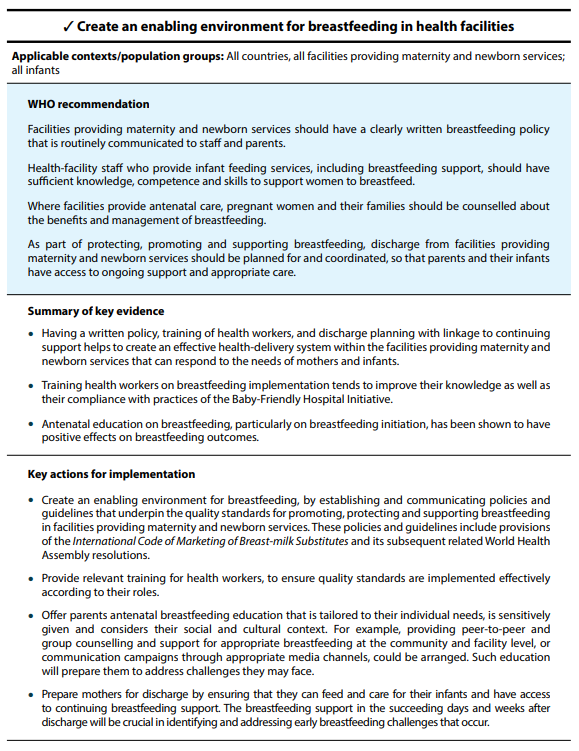This week at the United Nations General Assembly (UNGA), UN Member States adopted a landmark declaration on universal health coverage (UHC). Improving integration of nutrition interventions within health services is a key component of UHC and tackling malnutrition across all life stages. The World Health Organization (WHO) defines UHC as all people and populations having access to primary health care (promotive, preventative, curative, rehabilitative, and palliative health services) they need of sufficient quality and without financial risk [1]. At all ages across the life-course, nutrition interventions can play a vital role to optimize health and well-being.

To support mainstreaming nutrition interventions in primary healthcare, the WHO Department of Nutrition for Health and Development developed Essential nutrition actions: mainstreaming nutrition through the life-course. The new document aims to help decision-makers integrate essential nutrition actions (ENA) in national policies and strategies based on current WHO guidance and country priorities. This blog post explores ENA and how the new WHO document can be used to better scale-up nutrition interventions delivered through primary health care.
The Essential Nutrition Action Framework
In 1997, the WHO, UNICEF and United States Agency for International Development created the ENA framework, which encompassed an integrated package of high-impact nutrition interventions targeting women and young children during the first 1,000 days of life [2]. Nutrition interventions identified in the Lancet’s series on maternal and child nutrition in 2008 (and 2013 update) informed the ENA framework. In 2015, the ENA framework was expanded to include essential hygiene actions and social and behavior change communication. The newly released document advances the ENA framework to address both undernutrition and overnutrition.
Document highlights
Given current global dialogue on UHC, Essential nutrition actions: mainstreaming nutrition through the life-course is a timely release that highlights how nutrition is the foundation to achieving UHC and affects the entire life-course. The document is extremely user-friendly and well-organized, with four particularly helpful features:
1. ENA overview organized across continuum of care
Organizing ENA by life stage and primary health care type illustrates the potential for expanding ENA through health systems and health service contacts (see Figure 1). The document also lists other sectors that must be engaged to supports specific ENAs.

Figure 1. Essential Nutrition Actions Overview Table (pages 11-12)

Figure 1. Essential Nutrition Actions Overview Table (pages 11-12)
2. ENA checklist
ENA interventions are listed in a checklist that summarizes target population, applicable settings, and whether the intervention is WHO recommended (see Figure 2). This helps users quickly refer to interventions that may be relevant to their countries.

3. Detailed description of ENAs and WHO guidance
Each ENA section conveniently describes relevant WHO recommendations, key evidence, implementation guidance, and other considerations. While the WHO’s e-Library of Evidence for Nutrition Actions (eLENA) library includes similar information for nutrition interventions, this document is a more consolidated approach that emphasizes nutrition by life-stage and across the health system.

Figure 3. Sample of ENA section – enabling environment for breastfeeding in facilities (page 38)
4. Implementation guidance
The document concludes with a framework for implementing ENA, which comprises of needs assessments, advocacy, prioritization, policy development, and monitoring & evaluation. An underlying theme is how data can be used to inform and course-correct implementation.
Alignment with DataDENT activities
DataDENT’s work is motivated by a desire to improve the nutrition data value chain. By improving the collection and use of nutrition data, DataDENT believes that strong nutrition information systems are crucial to reducing malnutrition and reaching nutrition targets. In the past year, DataDENT has convened discussions on how to improve measurement of ENA in household and facility surveys, which resulted in a set of 11 recommended changes to the nutrition content in the Demographic and Health Surveys. DataDENT completed a mapping of ENA indicator definitions in July 2019, which is available to the public. DataDENT is currently developing a guide of how ENA should be measured in household survey questionnaires, which will include examples of recommended questions and indicator definitions.
- https://www.who.int/health_financing/universal_coverage_definition/en/
- https://www.spring-nutrition.org/publications/series/essential-nutrition-actions-and-essential-hygiene-actions
